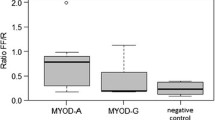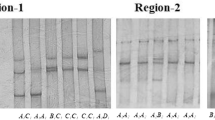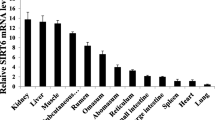Abstract
Myogenic factor 5 (Myf5), a product of the Myf5 gene, belongs to the MRF family of basic helix-loop-helix transcription factors that regulate myogenesis. Their roles in muscle growth and development make their genes candidates for molecular markers of meat production in livestock, but nucleotide sequence polymorphism has not been thoroughly studied in MRF genes. We detected four single nucleotide polymorphisms (SNPs) within exon 1 of the Myf5 gene, encoding the NH-terminal transactivation domain of the Myf5 protein. Three of these mutations change the amino acid sequence. The distribution of these SNPs was highly skewed in cattle populations; most of the mutations were found in only a few or even single individuals. Of the nine SNPs found in the promoter region of Myf5, one (transversion g.–723G→T) was represented by all three genotypes distributed in the cattle populations studied. This polymorphism showed an influence on Myf5 gene expression in the longissimus dorsi muscle and was associated with sirloin weight and fat weight in sirloin in carcasses of Holstein-Friesian cattle.


Similar content being viewed by others
References
Armstrong D, Esser KA (2005) Wnt/(beta)-catenin signaling activates growth-control genes during overload-induced skeletal muscle hypertrophy. Am J Physiol Cell Physiol 289:853–859
Barth JL, Worrell RA, Crawford M, Morris J, Ivarie R (1993) Isolation, sequence, and characterization of the bovine myogenic factor-encoding gene myf-5. Gene 127:185–191
Barton ER (2006) The ABCs of IGF-I isoforms: impact on muscle hypertrophy and implications for repair. Appl Physiol Nutr Metab 31:791–797
Borello U, Berarducci B, Murphy P, Bajard L, Buffa V, Piccolo S, Buckingham M, Cossu G (2006) The Wnt/β-catenin pathway regulates Gli-mediated Myf5 expression during somitogenesis. Development 133:3723–3732
Braun T, Winter B, Bober E, Arnold HH (1990) Transcriptional activation domain of the muscle-specific gene regulatory protein Myf5. Nature (London) 346:663–665
Brown T, Rudnicki MA, Arnold HH, Jaenisch R (1992) Targeted inactivation of the mouse regulatory gene Myf5 results in abnormal distal rib development and early postnatal death in homozygous mouse mutants. Cell 71:369–382
Brown T, Bober E, Rudnicki MA, Jaenisch R, Arnold HH (1994) MyoD expression marks the onset of skeletal myogenesis in homozygous Myf5 mutant mice. Development 120:3083–3092
Brunelli S, Relaix F, Baesso S, Buckingham M, Cossu G (2007) Beta catenin-independent activation of MyoD in presomitic mesoderm requires PKC and depends onPax3 transcriptional activity. Dev Biol 304:604–614
Casas E, Shackelford SD, Keele JW, Stone RT, Kappes SM, Koohmaraie M (2000) Quantitative trait loci affecting growth and carcass composition of cattle segregating alternate forms of myostatin. J Anim Sci 78(3):560–569
Cossu G, Borello U (1999) WNT signaling and the activation of myogenesis in mammals. EMBO J 24:6867–6872
Drogemuller C, Kempers A (2000) A TaqI PCR-RFLP at the bovine myogenic factor (MYF5) gene. Anim Genet 31:146
Edmondson DG, Olson EN (1993) Helix-loop-helix proteins as regulators of muscle specific transcription. J Biol Chem 268:755–758
Foucher I, Volovitch M, Frain M, Kim JJ, Souberbielle JC, Gan L, Unterman TG, Prochiantz A, Trembleau A (2002) Hoxa5 overexpression correlates with IGFBP1 upregulation and postnatal dwarfism: evidence for an interaction between Hoxa5 and Forkhead box transcription factors. Development 129:4065–4074
Gerber AN, Klesert TR, Bergstrom DA, Tapscott SJ (1997) Two domains of MyoD mediate transcriptional activation of genes in repressive chromatin: a mechanism for lineage determination in myogenesis. Genes Dev 11:436–450
Hagen IJ, Zadissa A, McEwan JC, Veenvliet BA, Hickey SM, Cullen NG, Morris CA, Wilson T (2005) Molecular and bioinformatic strategies for gene discovery for meat traits: a reverse genetics approach. Aust J Exp Agr 45:801–807
Hughes SM, Schiaffino S (1999) Control of muscle fiber size: a crucial factor in ageing. Acta Phys Scand 167:307–312
Ishibashi J, Perry RL, Asakura A, Rudnicki MA (2005) MyoD induces myogenic differentiation through cooperation of its NH- and COOH-terminal regions. J Cell Biol 171:471–482
Kanai N, Fuji T, Saito K, Jokohama T (1994) Rapid and simple method for preparation of genomic DNA from easily obtainable clotted blood. J Clin Pathol 47:1043–1044
Kassar-Duchossoy L, Gayraud-Morel B, Gomes D, Rocancourt D, Buckingham M, Shinin V, Tajbakhsh S (2004) Mrf4 determines skeletal muscle identity in Myf5:Myod double-mutant mice. Nature 431:466–471
Langlands K, Yin X, Anand G, Prochownik EV (1997) Differential interactions of Id proteins with basic helix loop helix transcription factors. J Biol Chem 272(32):19785–19793
Li C, Basarab J, Snelling WM, Benkel B, Murdoch B, Hansen C, Moore SS (2004) Assessment of positional candidate genes myf5 and igf1 for growth on bovine chromosome 5 in commercial lines of Bos taurus. J Anim Sci 82(1):1–7
Lisowski P, Pierzchała M, Gościk J, Pareek ChS, Zwierzchowski L (2008) Evaluation of reference genes for studies of gene expression in bovine liver, kidney, pituitary, and thyroid. J Appl Genet 49(4):367–372
Maak S, Neumann K, Swalve HH (2006) Identification and analysis of putative regulatory sequence for the MYF5/MYF6 locus in different vertebrate species. Gene 379:141–147
MacNeil MD, Grosz MD (2002) Genome-wide scans for QTL affecting carcass traits in Hereford × composite double backcross populations. J Anim Sci 80(9):2316–2324
Murre C, McCaw PS, Baltimore D (1989) A new binding and dimerization motif in immunoglobulin enhancer binding, daughterless, MyoD, and myc proteins. Cell 56:777–783
Oprządek J, Dymnicki E, Oprządek A, Słoniewski K, Sakowski T, Reklewski Z (2001) A note on the effect of breed of beef cattle on the carcass traits. Anim Sci Pap Rep 19:79–89
Perez-Ruiz A, Ono Y, Gnocchi VF, Zammit PS (2008) β-Catenin promotes self-renewal of skeletal muscle satellite cells. J Cell Sci 121:1373–1382
Pfaffl M (2001) A new mathematical model for relative quantification in real-time RT-PCR. Nucleic Acids Res 29:2002–2007
Ridgeway AG, Petropoulos H, Wilton S, Skerjanc SI (2000) Wnt signaling regulates the function of MyoD and myogenin. J Biol Chem 275(42):32398–32405
Rudnicki MA, Jaenisch R (1995) The MyoD family of transcription factors and skeletal myogenesis. BioEssays 17:203–209
Rudnicki MA, Schnegelsberg PN, Stead RH, Braun T, Arnold HH, Jaenisch R (1993) MyoD or Myf5 is required for the formation of skeletal muscle. Cell 75:1351–1359
Schwarz JJ, Chakraborty T, Martin J, Zhou J, Olson E (1992) The basic region of myogenin cooperates with two transcription activation domains to induce muscle specific transcription. Mol Cell Biol 12(1):266–275
Stratil A, Čepica S (1999) Three polymorphisms in the porcine myogenic factor 5 (MYF5) gene detected by PCR-RFLP. Anim Genet 30:79–80
Te Pas MF, Soumillion A (2001) The use of physiologic and functional genomic information of the regulation of the determination of skeletal muscle mass in livestock breeding strategies to enhance meat production. Curr Genomics 2:285–304
Te Pas MF, Harders FL, Soumillion A, Born L, Buist W, Meuwissen TH (1999) Genetic variation at the porcine MYF-5 gene locus: lack of association with meat production traits. Mamm Genome 10:123–127
Urbański P, Kurył J (2004) New SNPs in the coding and 5′ flanking regions of porcine MYOD1 (MYF3) and MYF5 genes. J Appl Genet 45(3):325–329
Urbański P, Flisikowski K, Starzynski R, Kurył J, Kamyczek M (2006) A new SNP in the promoter region of the porcine MYF5 gene has no effect on its transcript level in m. longissimus dorsi. J Appl Genet 47(1):59–61
Wang Y, Schnegelsberg PN, Dausman J, Jaenisch R (1996) Functional redundancy of the muscle-specific transcription factors Myf5 and myogenin. Nature 379:823–825
Acknowledgments
This study was funded by Polish Ministry of Science and Higher Education grants PBZ-KBN-113/P06/2005 and NN311 043434. The contribution of Dagmara Robakowska-Hyzorek was also financially supported by the scholarship funded by the President of the Polish Academy of Sciences. The authors thank Prof. Chandra S. Pareek and the Rajastan Go Sewa Sangh Organization, Bikaner, India, for providing hair samples of Rathi Zebu cattle.
Author information
Authors and Affiliations
Corresponding author
Rights and permissions
About this article
Cite this article
Robakowska-Hyżorek, D., Oprządek, J., Żelazowska, B. et al. Effect of the g.–723G→T Polymorphism in the Bovine Myogenic Factor 5 (Myf5) Gene Promoter Region on Gene Transcript Level in the Longissimus Dorsi Muscle and on Meat Traits of Polish Holstein-Friesian Cattle. Biochem Genet 48, 450–464 (2010). https://doi.org/10.1007/s10528-009-9328-1
Received:
Accepted:
Published:
Issue Date:
DOI: https://doi.org/10.1007/s10528-009-9328-1




